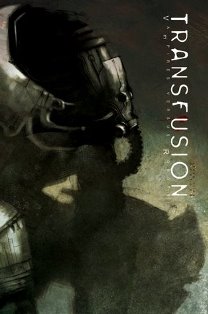
Originally published in a three-part comic series between October 2012 and February 2013, Steve Niles’ comic mini-series ‘Transfusion’ was later compiled into a single graphic novel volume in April 2013. Subtitled ‘Vampires Versus Robots’ the story was illustrated by artist Menton3 (along with Tony Moy within the final chapter – i.e. issue #3 of the original IDW comics).
DLS Synopsis:
After the first war, the entire planet was scorched – both land and sky. Seasons became a thing of the past. Those that remained suffered crippling cold during the long nights, and unbearable heat during the days. It was however, perfectly suited for the machines. They hunted humans and animals alike. Anything with blood and meat to fill their metallic bellies and grease their limbs.
The humans fought back as best they could, but they had long ago sold their souls to technology, and the very weapons they used turned against them.
It had only taken the robots five years to turn on the world. Since then, the bots had wiped nearly all life out. The numbers remaining were dwindling. The end of the human race was in sight.
However, with humans becoming extinct, the bots were now running out of fuel. And so were the others who fed on mankind’s lifeblood. The vampires…
DLS Review:
Steve Niles is certainly no stranger to the darker side of graphic novels - having already worked on the likes of the ‘I Am Legend’ (1991) comic book adaptation, ‘Night Of The Living Dead: London’ (1993) and ’30 Days Of Night’ (2002) to name but a few.
With ‘Transfusion’ Niles delivers a desolate post-apocalyptic world in which huge robots scour the land in search of any remaining humans to run their machines with. Indeed, the premise is a sort of cross between ‘The War Of The Worlds’ (1898), ’30 Days Of Night’ (2002) and James Herbert’s ‘The City’ (1994). However, Niles has painted a far bleaker, more depressing and desolate vision of a world ravaged by machines than these three combined.
Menton3’s artwork is particularly suited to the downbeat grimness of the story. The dull washed-out tones and starkly simplified line-work, compliment the depressive backdrop to the story perfectly. It’s a cold and uncaring world. One where mere survival is a constant struggle and the remaining survivors spend their time hiding away, wearing gasmasks to protect them from the heavily polluted atmosphere that perpetrates to air.
The story itself is told from the perspective of William – a vampire in a world almost devoid of any remaining humans. The revelation that William is a vampire is unveiled early on in the story. His role is to find any remaining humans and bring them back to his clan. It is a mission with little chance of success.
Niles tells the story with very few words, but rather relies much more heavily on the visual illustrations and sporadic use of dialogue. The narrative itself is very linear, but constantly shifting down different paths because of sudden revelations that seem to jump up quickly, with very little build-up.
Although incredibly bleak and depressing, interspersed with sudden bursts of high-octane violence every few pages, the story nevertheless feels strangely subdued – with the oppressive (and inevitable) doom of everything overshadowing any last attempts at survival.
The robots themselves are like something born from a nightmare. Thin needle pointed legs carry H.R. Giger like skull-headed death machines across the desolate landscape. Indeed, it’s undoubtedly the machines and their visual impact that really makes the graphic novel work. Almost Dali like in their exaggerated appendages – the feeling that this is a horrific nightmare rather than a vision of the future is almost unshakeable as you work your way through the gloomy tale.
The use of varying artwork throughout the entire length of the story is also intrinsic to its overall appeal and success. Artist Menton3 varies the style of art, from airbrush and watercolour to sketchy pen line-work page by page. This works particularly well with the overall style of story and its bleak sci-fi premise. However, when Tony Moy jumps into the fight, laying down four consecutive pages of sketchy pen & ink work at a critical action-rich moment – the effect is one of utter disappointment, culminating in the removal of the reader from the story. Indeed, at such a key turning point in the tale, the impact of this sudden (painfully unsuccessful) change in styles is incredibly detrimental – derailing the reader in one fell swoop and pretty much destroying what would have otherwise been a critical finale in the story.
That said, the graphic novel is still one damn entertaining read – although you’re likely to finish the entire thing with twenty minutes or so, even with taking time to slowly work through the illustrative artwork frame by frame.
The collected edition also includes a nineteen page ‘Sketch book & artwork’ section showcasing a variety of Menton3’s sketches and drawings for the project. Following this the collection concludes with a ten page working script detailing what Niles wanted to appear on each page, including a breakdown of each frame and associated dialogue.
The graphic novel runs for a total of 74 pages with an additional 19 pages for the ‘Sketch book & artwork’ and a further 10 pages for the working script.

© DLS Reviews






